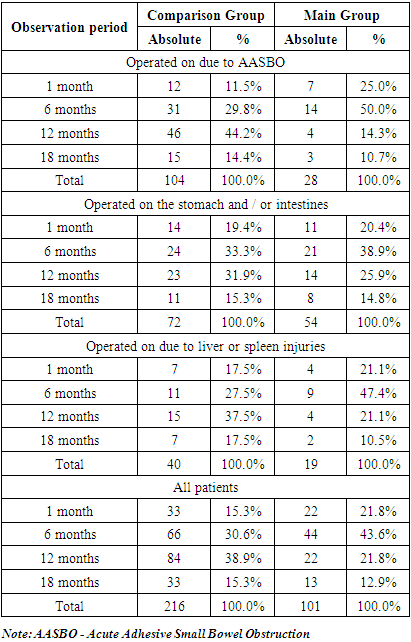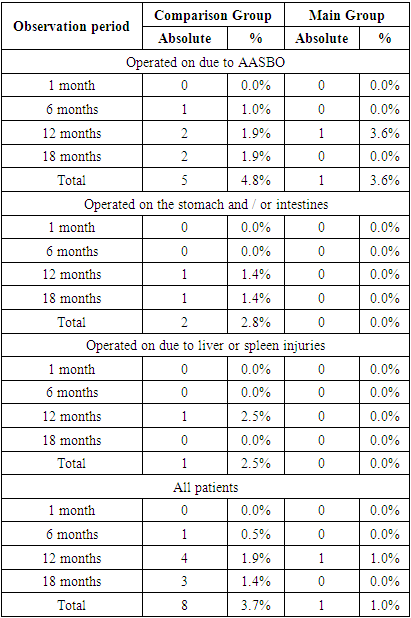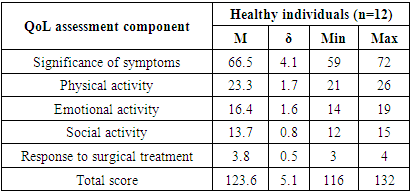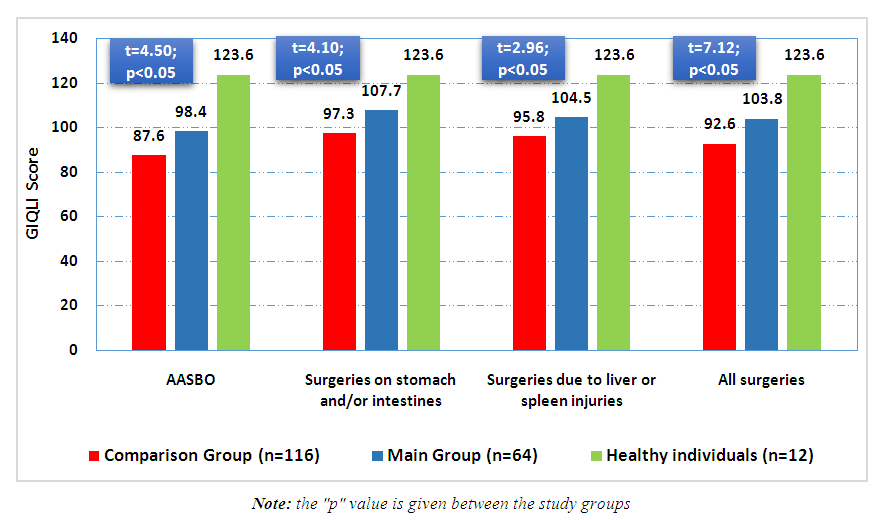S. I. Ismailov, G. B. Orazaliev, S. A. Sultanov, Bazarbaeva K. G.
Republican Specialized Scientific and Practical Medical Center for Surgery Named After Acad. V. Vakhidov, Beruni District Medical Association, Uzbekistan
Copyright © 2022 The Author(s). Published by Scientific & Academic Publishing.
This work is licensed under the Creative Commons Attribution International License (CC BY).
http://creativecommons.org/licenses/by/4.0/

Abstract
Aim of the study was to evaluate the anti-adhesive properties of the drug Hemoben in patients after various surgical interventions on the abdominal organs. Background. Numerous experimental, clinical and laboratory studies have been devoted to the prevention of postoperative adhesions. Taking into account the etiological factors and mechanisms for the formation of postoperative adhesions, a variety of methods have been proposed for their preventing. Material and methods. We analyzed the treatment results of 317 patients in the long-term period up to 18 months who underwent surgical interventions on the abdominal organs. The Main Group included 101 patients who were used Hemoben to prevent adhesions. The Comparison Group consisted of 216 patients who underwent interventions without the use of any anti-adhesive agents. In the long-term period from 3 to 18 months after surgery in 116 patients of the Comparison Group and 64 patients of the Main Group, the QoL level was assessed using a questionnaire Gastrointestinal Quality of Life Index (GIQLI) specially developed for such a cohort of patients. Results. The study of the subjective factor for evaluating antiadhesion efficiency based on a comparative analysis of the level of QoL according to the GIQLI questionnaire showed a higher value of this indicator in the Main Group in all major domains, except for the level of the “Social activity” component. The total score was 103.8±9.8 versus 92.6±10.8 points (t=7.12; p<0.05), which generally provided a higher correspondence to the group of healthy individuals (123.6±5 ,1 points), making up 74.9% in the Comparison Group and 84.0% - in the Main Group.
Keywords:
Adhesive intestinal obstruction, Anti-adhesion agents, Quality of life, Hemoben
Cite this paper: S. I. Ismailov, G. B. Orazaliev, S. A. Sultanov, Bazarbaeva K. G., Life Quality Indices After Various Abdominal Surgeries in Evaluation of the Anti-Adhesive Properties Efficiency of the Hemoben, American Journal of Medicine and Medical Sciences, Vol. 12 No. 6, 2022, pp. 653-658. doi: 10.5923/j.ajmms.20221206.09.
1. Introduction
The existence of adhesions leads to a decrease in the quality of life, chronic abdominal pain, infertility. In some cases, intestinal obstruction may be developed [1-3].In fact, adhesions are a specific pathological reaction of the peritoneum to inflammation existing in patients with cholecystitis, gastric ulcer, salpingitis, oophoritis, endometriosis, uterine fibroids. A previously developed adhesive disease is very often the cause of infertility in patients with tubal-peritoneal infertility.Numerous experimental, clinical and laboratory studies have been devoted to the prevention of postoperative adhesions. Taking into account the etiological factors and mechanisms for the formation of postoperative adhesions, a variety of methods have been proposed for their preventing [4-6]. The existing "barriers" are not a panacea, the search for new methods are having been continued. Scientific efforts are proposed to be directed towards the search for liquid substances for single intraperitoneal application, which will significantly reduce the incidence of postoperative adhesion formation at a reasonable cost, without adverse effects on the blood coagulation system and wound healing processes [7-8].
2. Material and Methods
We analyzed the treatment results of 317 patients in the long-term period up to 18 months who underwent surgical interventions on the abdominal organs. Patients were divided into two groups. The Main Group included 101 patients who were used Hemoben to prevent adhesions. The Comparison Group consisted of 216 patients who underwent interventions without the use of any anti-adhesive agents. (Tab. 1).Table 1. The number of patients followed up depending on the observation period
 |
| |
|
3. Results
As a result of follow-up in the long-term period for up to 18 months, it was possible to reveal the development of the Acute Adhesive Small Bowel Obstruction (AASBO) clinic in 2 (2.0%) patients of the main group and in 19 (8.8%) patients of the comparison group (Tab. 2). It should be noted that in patients who were operated on for injuries of the liver or spleen using Hemoben in the long-term period, the occurrence of AASBO clinic was not observed in any case. Table 2. Frequency of verification of AASBO development in the period from 1 to 18 months after surgery
 |
| |
|
1 (1.0%) patient of the main group and 8 (3.8%) of the comparison group from all patients with the developed AASBO clinic underwent surgical intervention (Tab. 3).Table 3. The number of patients with AASBO who required surgical treatment
 |
| |
|
The above data indicate only registered clinically significant cases of postoperative adhesive small bowel obstruction. In this regard, for a more objective analysis, the study was supplemented with a subjective assessment, which may also indirectly indicate the presence of an adhesive process affecting the condition of patients and their QOL. In the long-term period from 3 to 18 months after surgery in 116 patients of the Comparison Group and 64 patients of the Main Group, the QOL level was assessed using a questionnaire Gastrointestinal Quality of Life Index (GIQLI) specially developed for such a cohort of patients. Particular importance among 5 components of the GIQLI questionnaire assessment was given to such parameters as "Significance of symptoms" and "Response to surgical treatment", although other components were of no small importance ("Physical activity", "Emotional activity" and "Social activity"). In general, all components provided a total QOL score. For a better comparative analysis, a group of healthy individuals (12 people) was also studied, whose indicators were considered the standard for the study groups. For convenience and more complete information, the given numerical data reflected the following: the mean value (M), its standard deviation (δ), minimum value in the group (Min) and maximum value (Max).Data from a questionnaire of 12 healthy individuals were used for the control; the indicators of their quality of life are presented in Table 4.Table 4. The level of quality of life (GIQLI) in a group of healthy individuals
 |
| |
|
4. Results
A comparative analysis of both groups in terms of quality of life after surgery due to AASBO showed significant differences in four parameters: the significance of symptoms, physical activity and response to surgical treatment. These figures were higher in the main group (p<0.05) (Tab. 5).Table 5. Quality of life assessment (GIQLI) after AASBO surgery
 |
| |
|
However, in patients who underwent surgery on the stomach or intestines, as it can be seen from the data in Table 6, physical activity was the same as in the Comparison Group. Other indices did not differ in the level of reliability from patients operated on for AASBO. Table 6. Quality of life assessment (GIQLI) after surgeries on stomach and (or) intestine
 |
| |
|
Similar data were observed in patients who underwent surgery for liver and spleen injuries, where the quality index of physical activity in both groups did not differ (Tab. 7). Table 7. Quality of life assessment (GIQLI) after surgeries due to liver or spleen injuries
 |
| |
|
However, when analyzing the cumulative assessment of the quality of life after all surgeries, the indices were higher in patients of the Main Group (p<0.05) and only one index (Emotional activity) did not reveal a significant difference between two groups (Tab. 8).Table 8. Summary assessment of the quality of life (GIQLI) after all surgeries
 |
| |
|
In a comparative aspect, in patients of the Main Group where the antiadhesive drug Hemoben was used after various surgeries on the abdominal organs, the QoL indices approached those in healthy individuals and were significantly higher (t=7.12; p<0.05) than in patients of the Comparison Group (Fig. 1, 2). | Figure 1. Comparative indices of the quality of life index (total GIQLI scores) depending on the surgery |
 | Figure 2. The ratio of the quality of life index in the study groups in relation to healthy individuals |
5. Discussion
Thus, a clinical assessment of the prevention of postoperative adhesive process development in the abdominal cavity showed that the use of Hemoben bio-coating both on top of parenchymal organs in traumatic injuries, and locally in the area of the parietal and visceral peritoneum injury, in terms of up to 18 months of follow-up, reduced the incidence of clinically significant cases of postoperative AASBO from 8.8% (in 19 from 216 patients of Comparison Group), to 2.0% (in 2 from 101 patients of the Main Group). At the same time, the largest proportion of patients (13 from 19 and 1 from 2, respectively) were after previously undergone surgeries due to this complication. Conservative resolving of AASBO was successful in 11 from 19 patients in the Comparison Group and in 1 from 2 cases in the Main Group, whereas in 3.7% (8 patients) and 1.0% (1 patient), this complication required surgical treatment. The study of the subjective factor of assessing the anti-adhesive efficiency by comparative analysis of the QoL level according to the GIQLI questionnaire showed a higher value of this index in the Main Group. Thus, a higher value of QOL was obtained for 4 out of 5 domains, in particular, according to the criterion "Significance of symptoms", the index in the Comparison Group was 49.1 ±9.3 points, and in the Main Group – 57.0±8.6 points (t=5.71; p<0.05); "Response to surgical treatment" - 2.1±0.6 vs. 2.5±0.6 points (t=4.36; p<0.05); "Physical activity" - 17.9±3.1 vs. 19.3±2.5 points (t=3.43; p<0.05) and "Social activity" - 10.7±1.8 vs. 11.5±1.4 points (t=3.71; p<0.05). Only in the domain "Emotional activity" the difference was not significant - 12.8 ± 2.7 versus 13.4± 2.1 points (t=1.61; p>0.05). In general, the total score was higher in the main group – 103.8±9.8 versus 92.6±10.8 points (t=7.12; p<0.05), which generally provided a higher correspondence to the group of healthy individuals (123.6±5.1 points) making up 74.9% in the Comparison Group and 84.0% in the Main Group.
6. Conclusions
A clinical assessment of the prevention of postoperative adhesive process development in the abdominal cavity showed that the use of Hemoben bio-coating both on top of parenchymal organs in traumatic injuries, and locally in the area of the parietal and visceral peritoneum injury, in terms of up to 18 months of follow-up, reduced the incidence of clinically significant cases of postoperative AASBO from 8.8% (in 19 from 216 patients of Comparison Group). The study of the subjective factor of assessing the anti-adhesive effectiveness by comparative analysis of the QoL level according to the GIQLI questionnaire showed a higher value of this index in the Main Group for all major domains, except for the level of the "Social activity" component. The total score was higher in the main group – 103.8±9.8 versus 92.6±10.8 points (t=7.12; p<0.05), which generally provided a higher correspondence to the group of healthy individuals (123.6±5.1 points) making up 74.9% in the Comparison Group and 84.0% in the Main Group.
References
| [1] | Fredriksson, F. Outcome and prevention strategies in peritoneal adhesion formation. – Uppsala, 2016. – 65 p. |
| [2] | Ouaïssi M, Gaujoux S, Veyrie N, Denève E, et al. Post-operative adhesions after digestive surgery: their incidence and prevention: review of the literature. J Visc Surg. 2012; 149(2): e104-e114. doi: 10.1016/j.jviscsurg.2011.11.006. |
| [3] | Sisodia, V. Clinical profile of patients with postoperative adhesive intestinal obstruction and its association with intraoperative peritoneal adhesion index / V. Sisodia, S.K. Sahu, S. Kumar // Chirurgia. – 2016. – Vol. 111, № 3. – P. 251–8. |
| [4] | Chapelle, S.L. Understanding and approach to treatment of scars and adhesions. Introduction / S.L. Chapelle // Manual physical therapy for non-surgical treatment of adhesion-related small bowel obstructions: two case reports. - 2016. - Ch. 51. - P. 1-16. |
| [5] | Ten Broek RPG, Krielen P, Di Saverio S, Coccoliniet F, et al. Bologna guidelines for diagnosis and management of adhesive small bowel obstruction (ASBO): 2017 update of the evidence-based guidelines from the world society of emergency surgery ASBO working group. World J Emerg Surg. 2018; 13(1): 24. doi: 10.1186/s13017-018-0185-2. |
| [6] | Yamamoto, Y., Miyagawa, Y., Kitazawa, M. et al. Impact of barometric pressure on adhesive small bowel obstruction: a retrospective study. BMC Surg 20, 168 (2020). |
| [7] | Dobrokhotova Yu.E., Grishin I.I., Grishin A.I., Komagorov V.I. The use of anti-adhesive gels in intrauterine surgery. Breast cancer. Mother and child. \ In Russian. 2018; 1(1): 71-75. DOI: 10.32364/2618-8430-2018-1-1-71-75. |
| [8] | Meshkova O.A., Bogdanov D.Yu., Matveev N.L., Kurganov I.A. Application of modern anti-adhesive drugs in surgery. In Russian // Endoscopic surgery, 3, 2015 с. 37-42. doi: 10.17116/endoskop201521337-42. |




 Abstract
Abstract Reference
Reference Full-Text PDF
Full-Text PDF Full-text HTML
Full-text HTML






